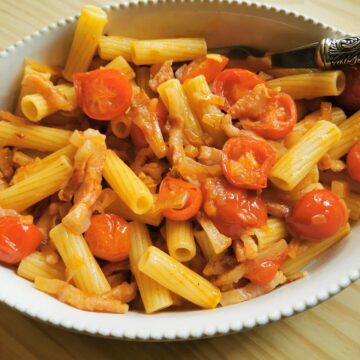This rigatoni pasta recipe with shallots and guanciale is based on a traditional dish from Emilia-Romagna, where they cultivate sweet Romagna shallots. It’s easy to make, extremely tasty and, of course you can use other types of shallots too!
Rigatoni con scalogno di Romagna é guanciale.
One of the many things I love about Italy is that every Italian region is well-known for the cultivation, production and processing of certain foods. Some products or crops are particular to only one or two regions (think Gorgonzola cheese). Others are grown or produced mostly only in the South (tomatoes) or the North (risotto rice). A few can be found throughout almost all the Italian peninsula (olive oil).
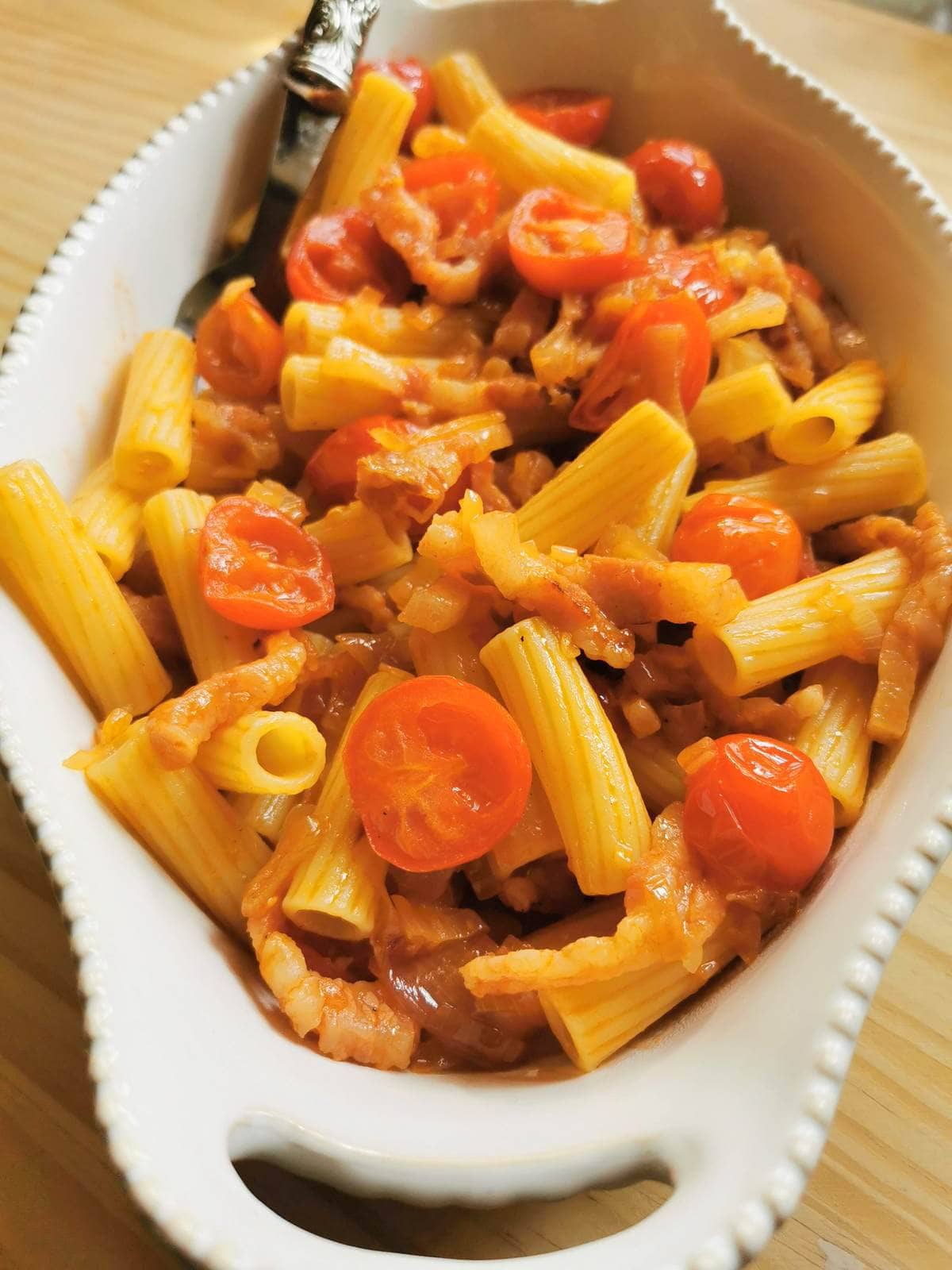
Food from Emilia-Romagna.
The Emilia-Romagna region produces quite a number of well-loved foods. Most Italian food lovers will know Parmiggiano Reggiano, balsamic vinegar from Modena or Prosciutto di Parma (Parma ham).
But, this region is also famous for vegetables such as asparagus, garlic and shallots. The latter known as Scalogno di Romagna (Romagna shallots) are a type of shallot that is grown in only 3 areas in Emilia-Romagna; in the provinces of Bologna, Forli and Ravenna.
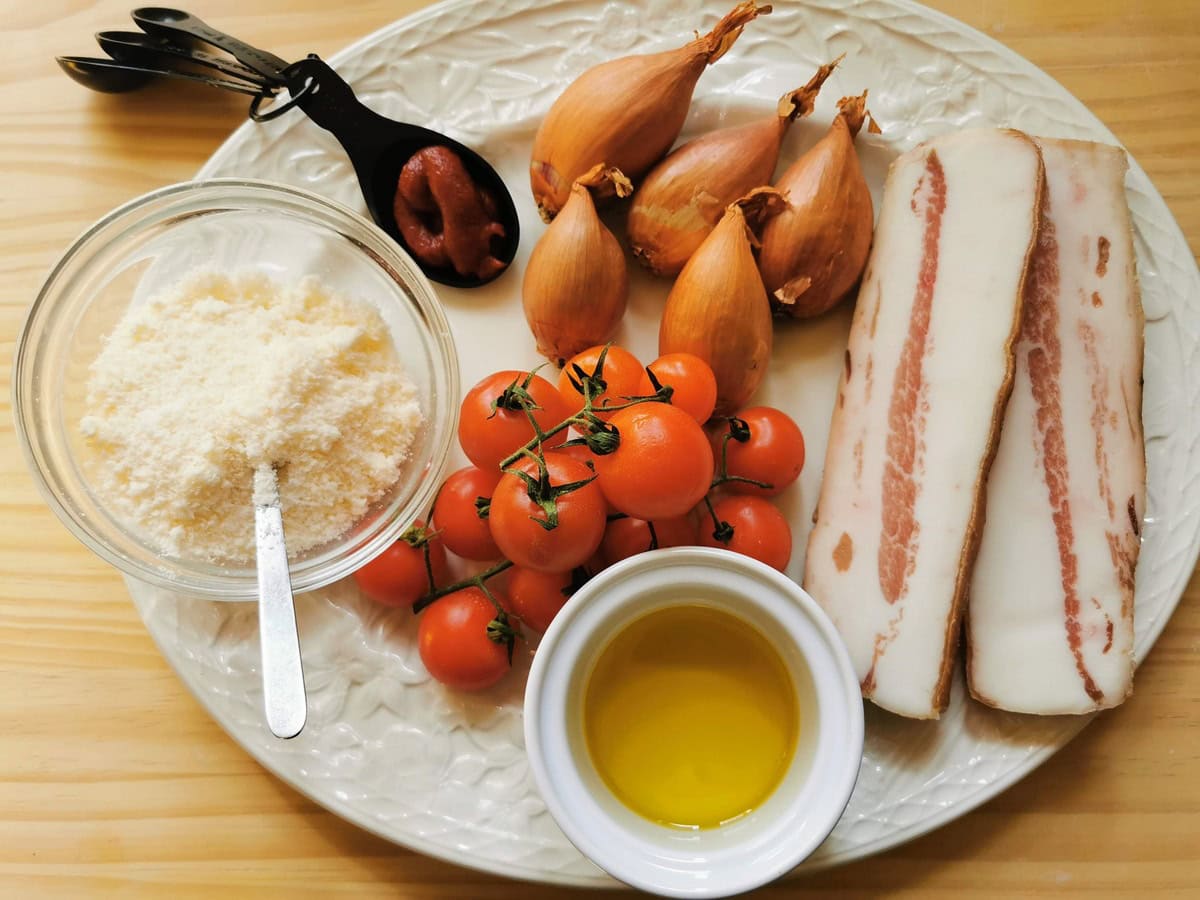
More about Romagna Shallots.
The Scalogno di Romagna is a pear-shaped shallot that is said to have originated in Palestine. However, shallots have been cultivated in Italy for 5,000 years. Apparently the ancient Romans liked them! The Romagna shallot is a purplish white color. But, it is wrapped in an external skin of different colors,from copper to reddish brown.
The taste of these shallots is definitely particular, stronger and more fragrant than that of an onion and sweeter than garlic. This makes it very versatile on a gastronomic level. In fact, it’s used a lot in the regional cuisine and often included in pasta recipes like this rigatoni pasta with shallots and guanciale (pork cheek/jowl).
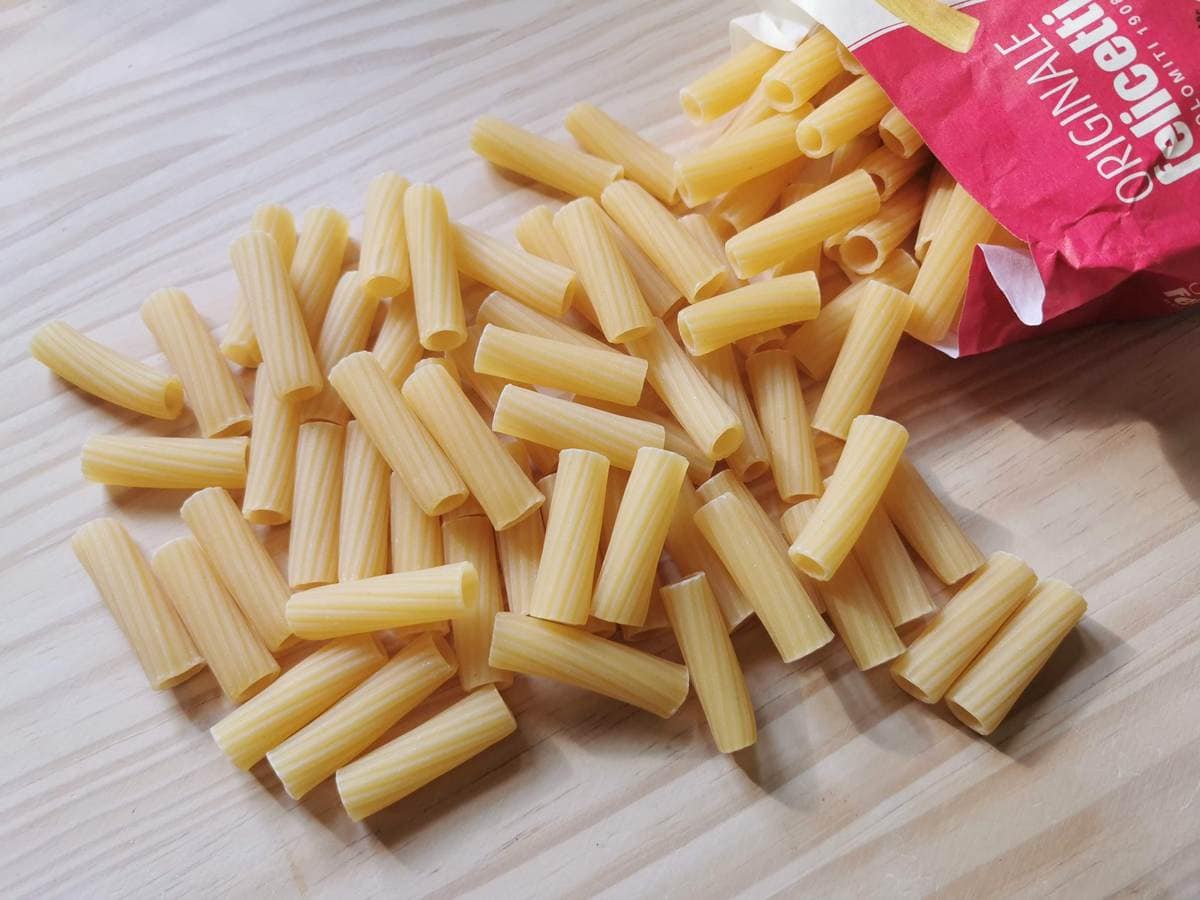
The Pasta.
For this shallot pasta recipe, I used dried rigatoni. Rigatoni is a type of pasta tube with grooves or ridges that run down the length of each tube. In fact, the name rigatoni comes from the Italian ‘rigate’ meaning ridged, grooved or lined. This is a popular pasta throughout Italy, but particularly in Sicily and in Rome.
However, you can also use other pasta types with this shallot based sauce. In Emilia-Romagna, you can find pasta with shallots made with garganelli or flat egg pastas like tagliolini, known as curzul in the local dialect, or tagliatelle, another well-known Emilia-Romagna food product.

Rigatoni Pasta with Romagna shallots.
There are a few different versions of pasta with Romagna shallots. Some include tomatoes (canned tomatoes or fresh), especially if made without meat. In fact, the simplest version is made with just pasta, Romagna shallots and tomatoes!
Other versions may include pancetta or guanciale with or without tomatoes. I used tomatoes and guanciale. Guanciale is cured pork jowl or cheek and is the star ingredient of a number of classic pasta recipes such as carbonara, alla gricia and amatriciana. Of course, you can use pancetta instead. A mild Italian sausage would also work well in this recipe.
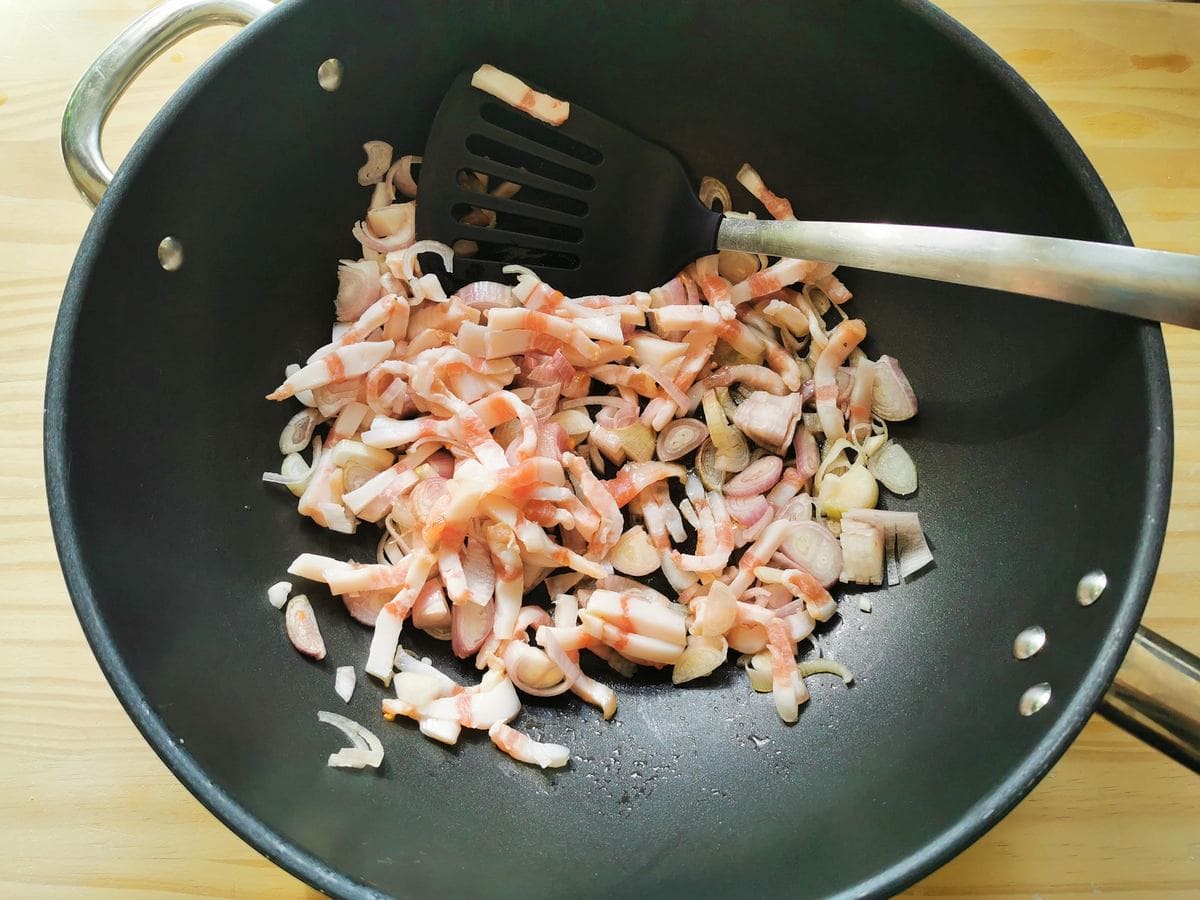
What is the difference between guanciale and pancetta?
You may ask what is the difference between pancetta and guanciale. Firstly, price and availability. Pancetta is usually easier to find and costs less (even here in Italy). But, both are unsmoked cured pork. Pancetta comes from the belly and guanciale from the jowl or cheek.
Guanciale definitely has a stronger taste than pancetta. However, it’s softer and more delicate and the fat often melts away giving more flavour to the dish. Having said that, pancetta is delicious too and better if you want crispy pieces in your dish!
Making this Rigatoni pasta with shallots.
Although this dish is traditionally made with Romagna shallots, you can use other types of shallots. Look for sweet ones. I wouldn’t recommend onions though!
Apart from the shallots, tomatoes, and guanciale (pork cheek/jowl) or pancetta all you need is some extra virgin olive oil, white wine, tomato concentrate (tomato paste), grated Parmigiano (parmesan cheese) and, of course, the pasta!
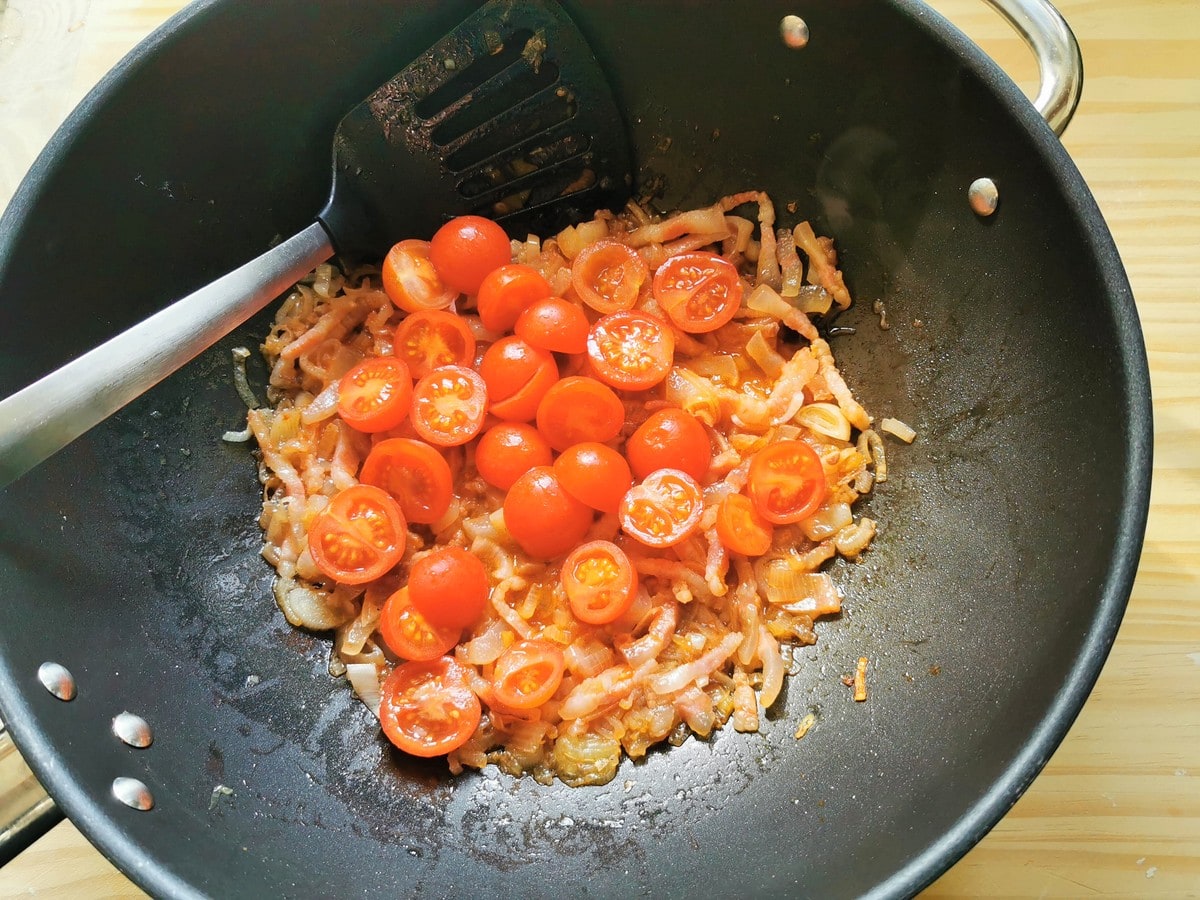
Step by step instructions.
1) Prepare the ingredients; peel and thinly slice the shallots, cut the guanciale into thin short strips and wash the cherry tomatoes and halve them.
2) Sauté the shallots and guanciale in a little olive oil over a medium heat until the shallots soften and the guanciale fat starts to melt and brown slightly.
3) Add the white wine and let the alcohol evaporate. Then add the tomato concentrate and a little water. Mix everything together.
4) Add the cherry tomatoes. Cook covered over a low heat for about 20 minutes.
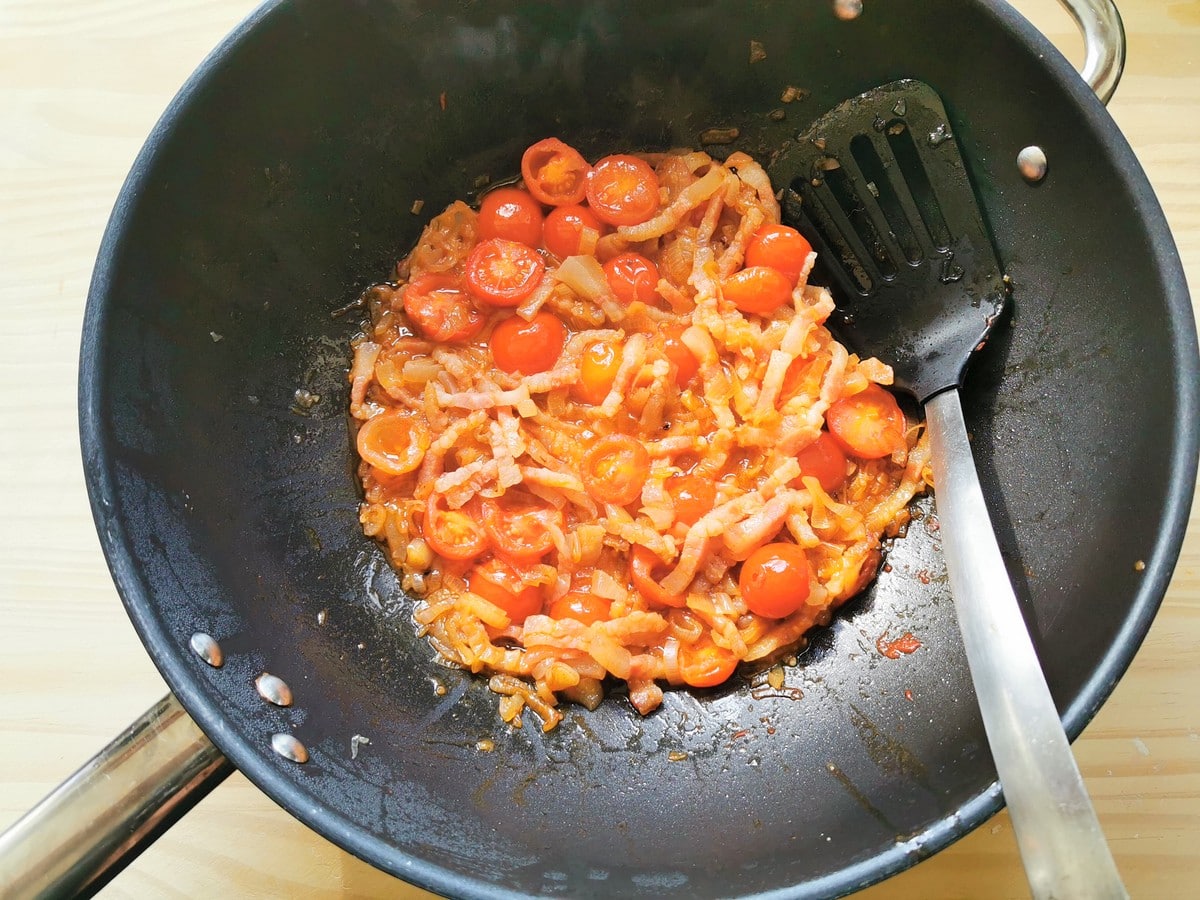
5) While the sauce is cooking, put a large pot of water onto boil for the rigatoni. Add salt once it starts to boil and bring to the boil again. Cook the rigatoni al dente according to the instructions on the package.
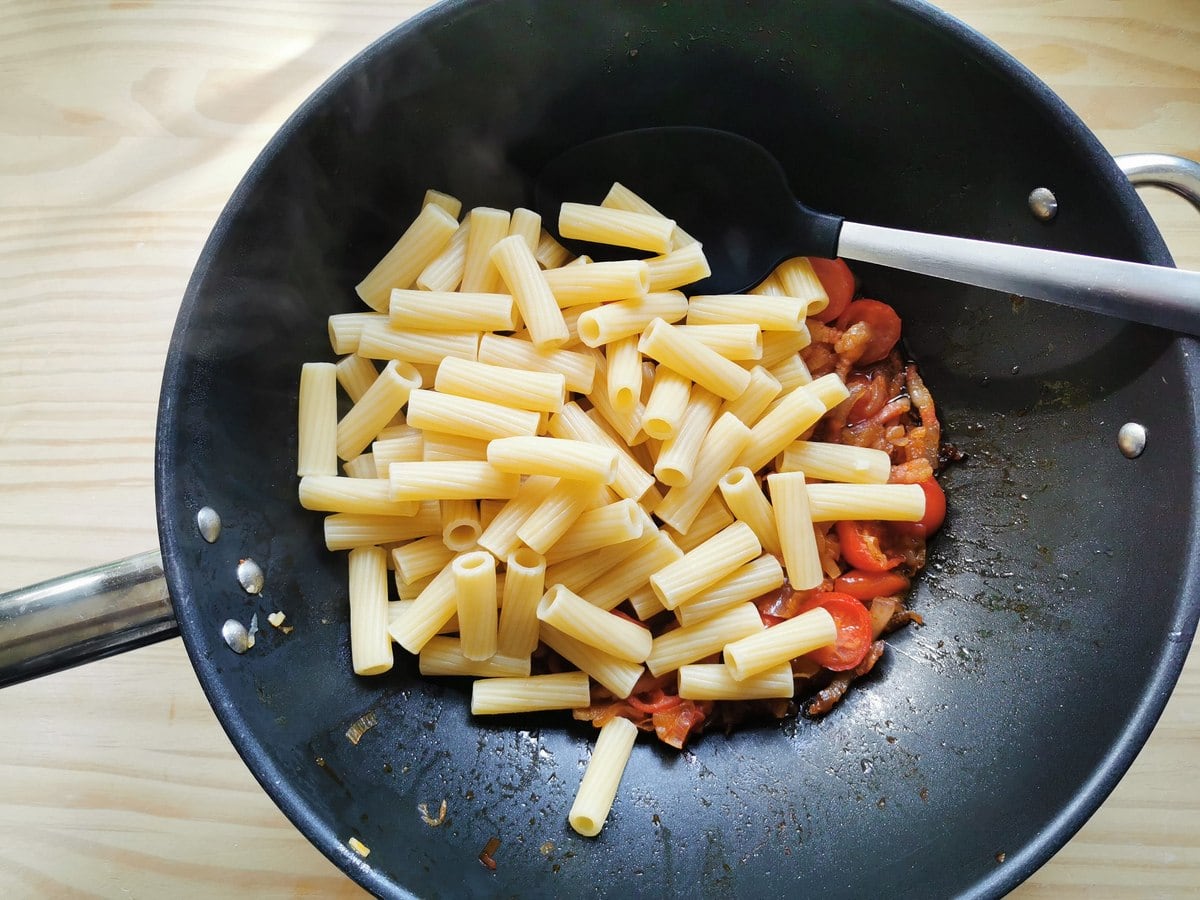
6) Save some of the pasta water and drain the pasta. Add it to the shallot sauce. Mix everything together over a low heat. If the sauce seems dry, add some of the pasta cooking water.
7) Serve your rigatoni pasta with shallots immediately with grated Parmigiano and, optionally, some crushed red pepper flakes (peperoncino) if you’d like to spice it up a bit.
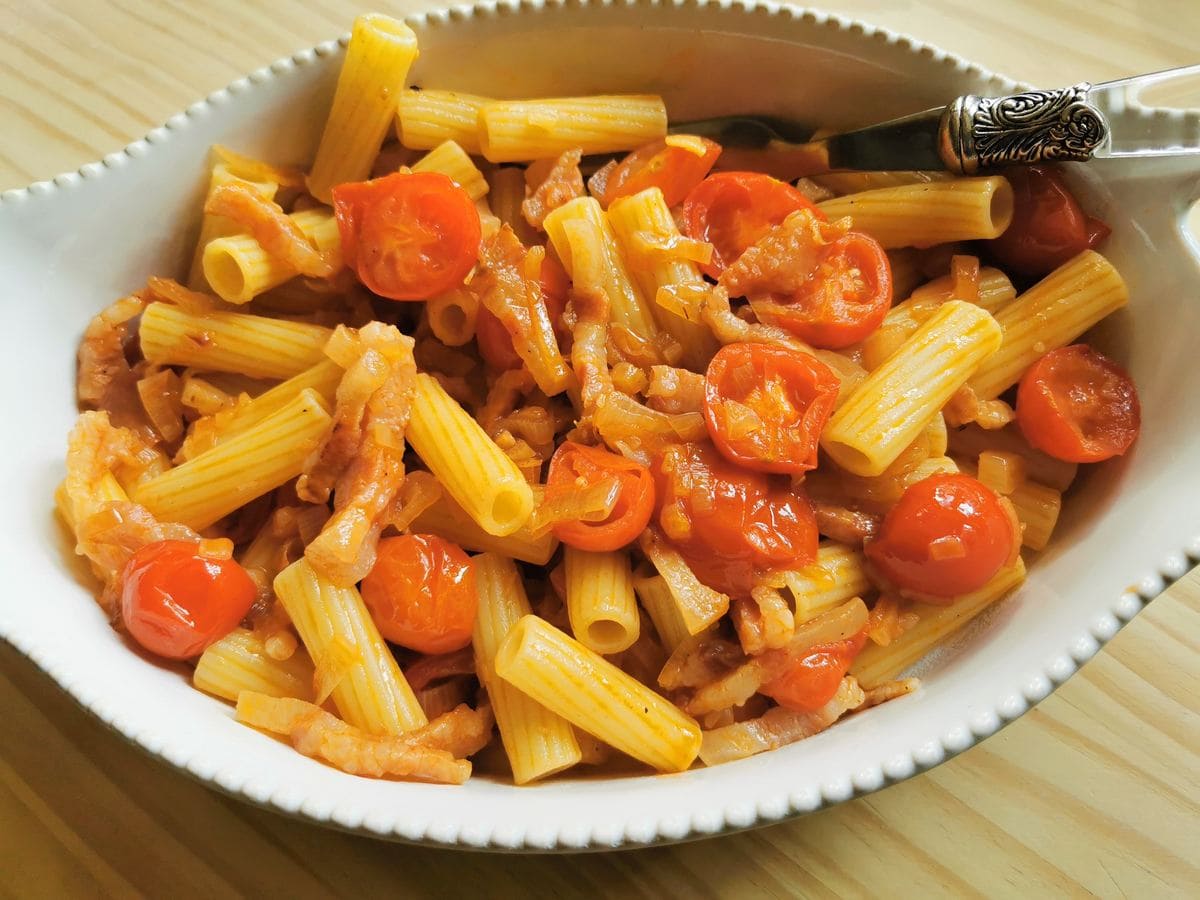
What to do with leftovers.
You can keep any leftover rigatoni with shallots in a sealed container in the fridge for up to 3 days. Leftovers are delicious baked with a sprinkling of more parmesan cheese on top. You can also reheat the pasta and shallot sauce in the microwave. I don’t recommend freezing this dish.
Pin for later.
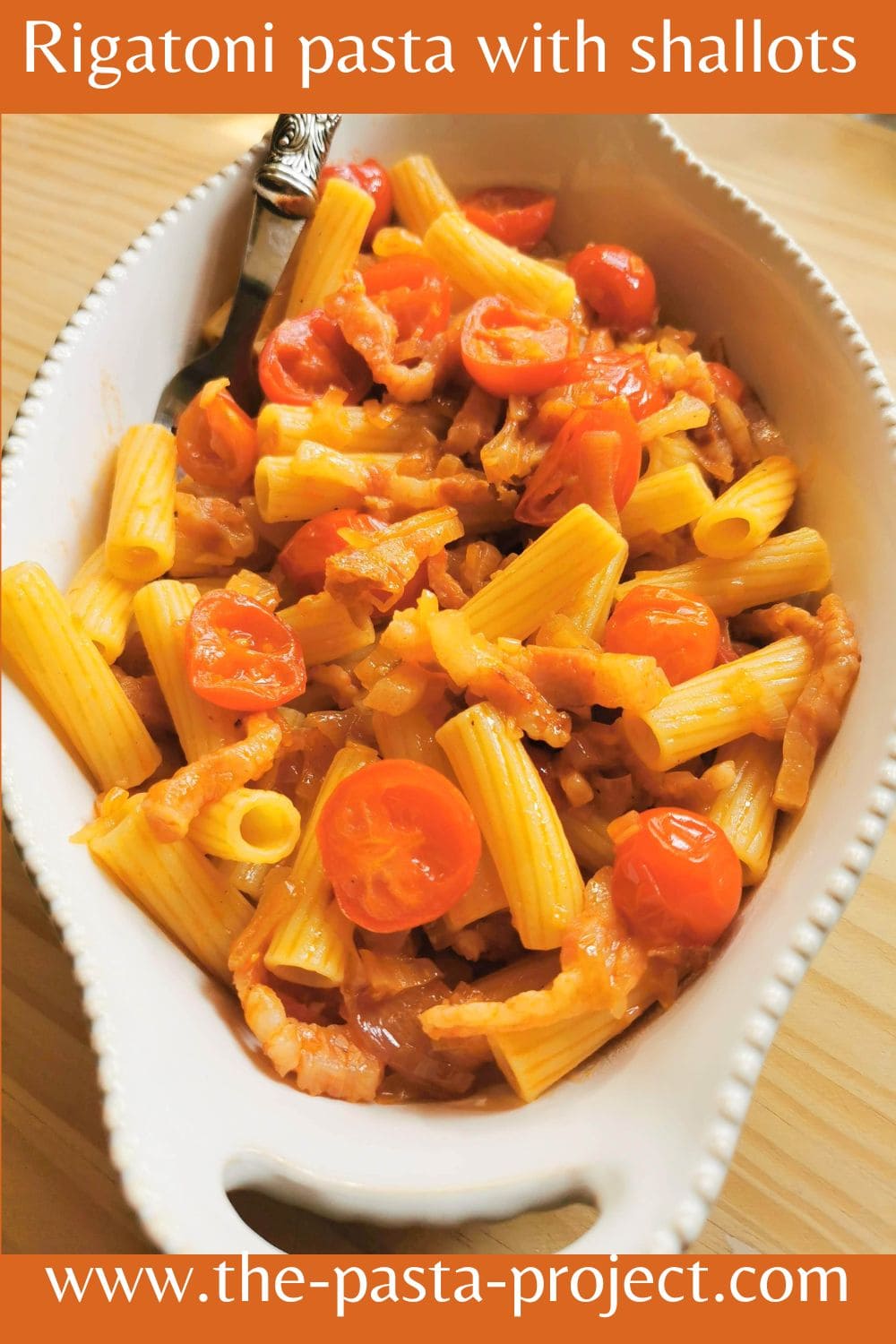
A quick and easy rigatoni recipe.
This is a quick, easy and delicious recipe that can be made in almost the time it takes to boil the water and cook your pasta. Perfect for busy weeknights and when you don’t want to spend much time in the kitchen!
Like many other simple Italian pasta recipes, rigatoni pasta with shallots and guanciale is incredibly tasty despite the few ingredients. I’m sure you’ll agree once you try it!
If you make this pasta with shallots recipe, I’d love to hear how it turns out and if you liked it. So, please leave a comment here on the blog or on The Pasta Project Facebook page.
Looking forward to hearing from you!
Buon appetito!
Some other pasta dishes from Emilia-Romagna
- Tagliatelle Bolognese
- Lasagne al forno with Bolognese
- Garganelli alla Zingara
- Baked Passatelli with pancetta and pine nuts
- Gramigna with sausage
Save this recipe for later?
If you want to save this recipe for later, you can print it, bookmark this page or save it to Pinterest.
Pin for Later!
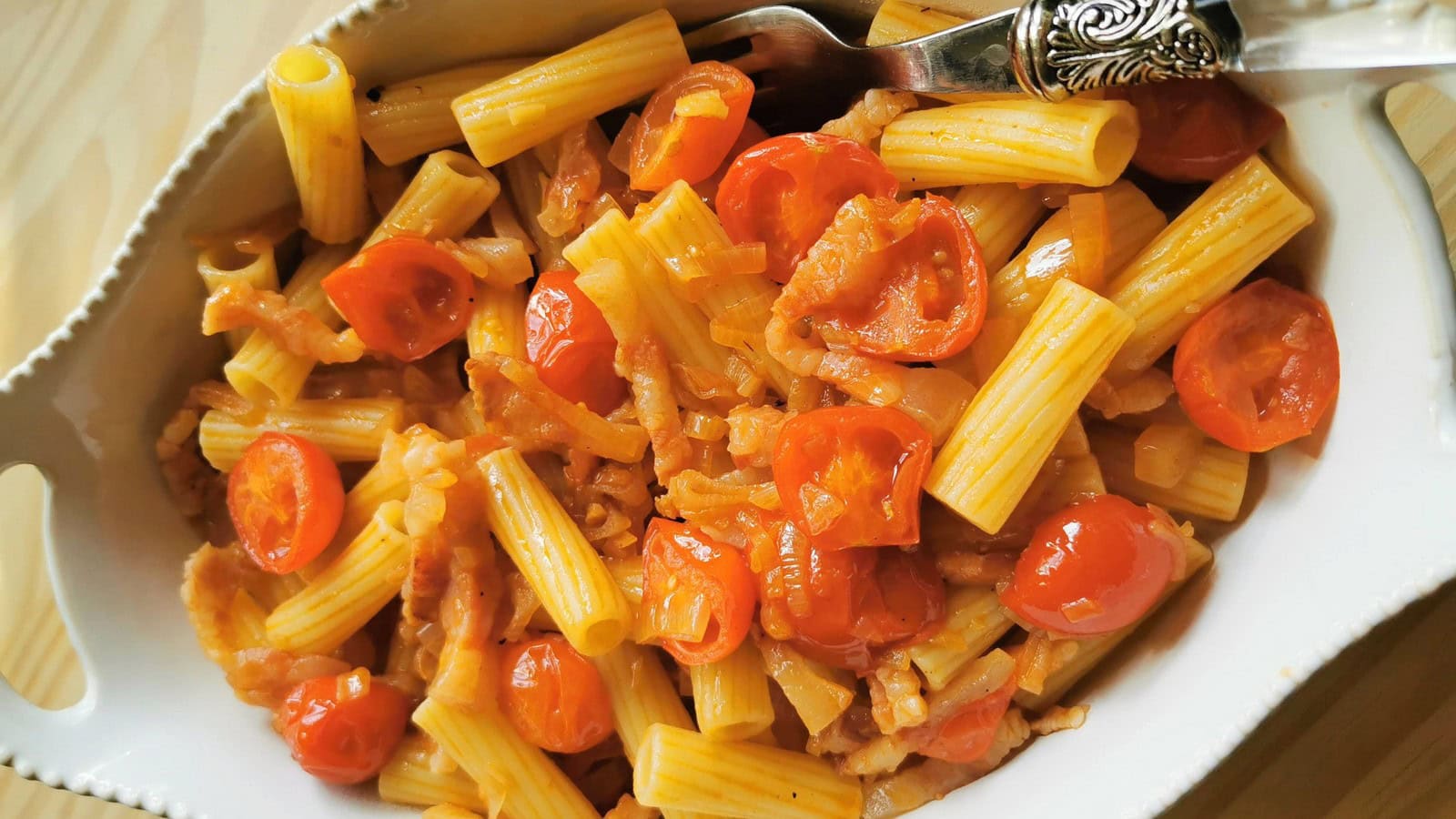
Reader Interactions


